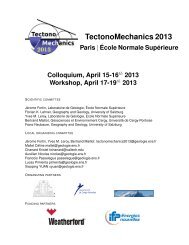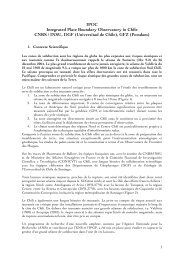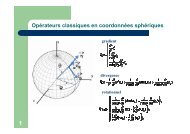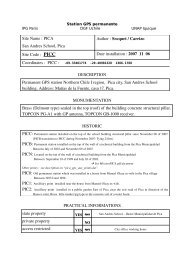PDF file - Laboratoire de Géologie de l'Ecole normale supérieure - Ens
PDF file - Laboratoire de Géologie de l'Ecole normale supérieure - Ens
PDF file - Laboratoire de Géologie de l'Ecole normale supérieure - Ens
You also want an ePaper? Increase the reach of your titles
YUMPU automatically turns print PDFs into web optimized ePapers that Google loves.
NATURE|Vol 436|14 July 2005 ARTICLES<br />
(SAMP) and the Malaysian peninsula, but fails to predict the large<br />
<strong>de</strong>formation observed in the northern part of the network (Fig. 2).<br />
Only half of the observed <strong>de</strong>formation (15 cm instead of 27 cm) is<br />
predicted at Phuket island (PHKT). Only one-third of the observed<br />
<strong>de</strong>formation (3 cm instead of 8 cm) is predicted at Bangkok (BNKK).<br />
Finally, insignificant displacements are predicted further north in<br />
China and further west in continental India, which is in contradiction<br />
with the observations. Therefore, we can conclu<strong>de</strong> that a much<br />
longer rupture must be consi<strong>de</strong>red.<br />
A second mo<strong>de</strong>l (not shown) was then constructed by simply<br />
prolonging the rupture plane further north to a total length of<br />
1,000 km. All other parameters were kept i<strong>de</strong>ntical to those of<br />
mo<strong>de</strong>l A. Although this simple mo<strong>de</strong>l fails to predict the <strong>de</strong>tails<br />
of the observed <strong>de</strong>formation field (in particular, the directions in<br />
continental Malaysia), it matches better the observed far-field <strong>de</strong>formation,<br />
both in amplitu<strong>de</strong> and direction, with an average misfit<br />
reduced to 12 mm. The corresponding seismic moment is increased<br />
to 7 £ 10 22 N m and the magnitu<strong>de</strong> to M w ¼ 9.2. However, it is very<br />
clear that such a rupture plane does not follow the trench direction in<br />
this area. The trench is curved to an almost north–south azimuth<br />
above a latitu<strong>de</strong> of 58 N. Therefore, we constructed a third mo<strong>de</strong>l<br />
(mo<strong>de</strong>l B) by simply cutting the previous plane into two planes: the<br />
southernmost one with a length of 450 km and the original strike of<br />
3308, and the second one with a length of 550 km and striking 3508.<br />
The total length and the slip being i<strong>de</strong>ntical to those of the previous<br />
mo<strong>de</strong>l, the seismic moment and the magnitu<strong>de</strong> remained<br />
unchanged. The better alignment with the trench leads to a better<br />
Figure 3 | Best-fit elastic mo<strong>de</strong>l of the co-seismic displacements using<br />
non-homogeneous slip along the rupture plane. Colour co<strong>de</strong> indicates the<br />
amount of slip from 0 (dark blue) to 35 m (dark red). Note that the area with<br />
significant slip is approximately 1,100 km long. Measured displacements<br />
(purple vectors) and mo<strong>de</strong>lled <strong>de</strong>formation (green vectors) are also<br />
<strong>de</strong>picted. Thin red lines <strong>de</strong>pict major faults 8 .<br />
© 2005 Nature Publishing Group<br />
fit with the observed <strong>de</strong>formation (the average misfit is now reduced<br />
to 10 mm), mostly in the predicted <strong>de</strong>formation direction, as<br />
expected (Fig. 2). This is true in particular in the central part of<br />
the network, in northern Malaysia and Thailand. As good as it is, this<br />
mo<strong>de</strong>l still predicts too much <strong>de</strong>formation in the southern part of the<br />
Malaysian peninsula. Here, the observed displacements are consistently<br />
smaller (by 1 cm on average) than the predicted ones and point<br />
more to the north. Reduction of predicted <strong>de</strong>formation in south<br />
Malaysia can only be achieved by reducing the amount of slip on the<br />
southern part of the rupture. In fact, a fourth mo<strong>de</strong>l (not shown)—in<br />
which we impose a reduced slip of only 3 m on the first half of the<br />
southern plane, balanced by an increased slip on the second half—<br />
yields an even better fit, with an average misfit reduced to 8 mm.<br />
In or<strong>de</strong>r to investigate the effect of non-homogeneous slip on the<br />
fault, we construct a mo<strong>de</strong>l with a grid of multiple no<strong>de</strong>s on which we<br />
invert the amount of slip, keeping its direction fixed. The surface fault<br />
geometry follows the mapping of ref. 8, the dip angle is fixed to 138<br />
according to USGS <strong>de</strong>termination 6 , and the maximum <strong>de</strong>pth is<br />
50 km. All mo<strong>de</strong>ls providing a good fit require a very small amount<br />
of slip on the southernmost part of the rupture (which starts around<br />
Simelue island, Indonesia), a very localized patch of very large slip<br />
(.20 m) in front of Phuket, Thailand, and a third patch of slip more<br />
spread out further north. All mo<strong>de</strong>ls also require that slip stops<br />
Figure 4 | Kinematic solution of the co-seismic displacements for 33<br />
continuous GPS stations in southeast Asia. Each curve shows the variation<br />
in the horizontal position of a given station during 1 h around the time of the<br />
earthquake (1 point every 30 s). Curves are sorted by distance to the<br />
earthquake epicentre, from 450 km for station SAMP (Medan, northern<br />
Sumatra, top) to 1,500 km for station CHMI (Chiang Mai, Thailand,<br />
bottom). The vertical full line indicates the time of the earthquake (0 h<br />
59 min) and the second, oblique, dashed line indicates the expected surface<br />
wave arrival time assuming a group velocity of 3.6 km s 21 .<br />
203






